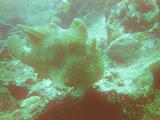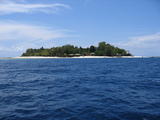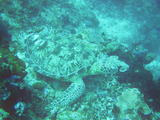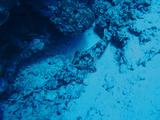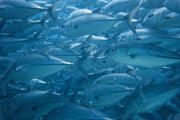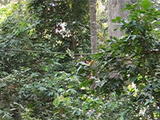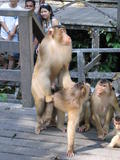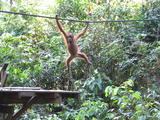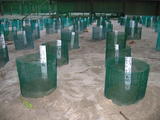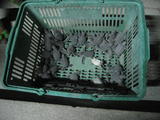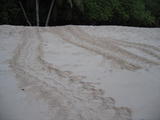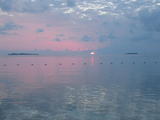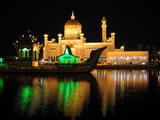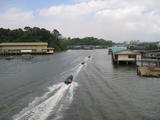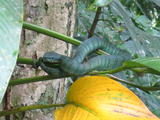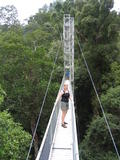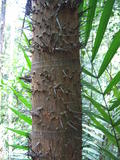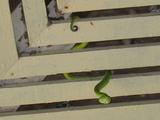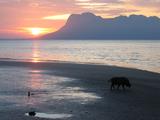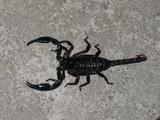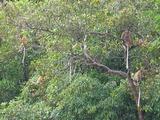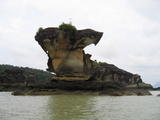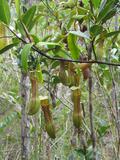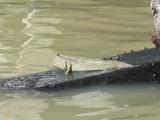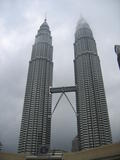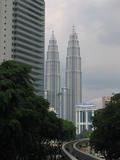| < < < Previous story | Next story > > > | |
The Unique Wildlife of BorneoMalé & Bangalore, 9 May 2005
Contents:Diving at SipadanWe found a cheap flight from Bangkok to Kota Kinabalu with Air Asia. This was great as it brought us directly to Borneo so we could avoid traveling via Kuala Lumpur, saving us some time and money. The first thing that I wanted to do, was learn to dive, several places in South East Asia had passed my review, but I had finally settled on Semporna and Sipadan. This was one of the main reasons to come to Borneo In Semporna, I followed a 3 day diving course, at the end of which I received my PADI open water diver certification. It was a fast course and the closed water training dives, which are supposed to be held in a swimming pool, were in the open sea, in a shallow area off an island. After the first basic dive in shallow water, I did another 5 dives as part of the course at Sibuan island, Sabangkat island (twice), Bohedulang and Church reef. I was learning while watching beautiful coral, lionfish, nudibranchs, frogfish, crocodilefish, hawksbill and green turtles pass below me! This was definitively a great place to learn diving. After passing the exam with perfect marks, we went to dive off Sipadan itself, which deservedly ranks as one of the top diving spots in the world. We saw an uncountable number of hawksbill turtles, green turtles and sharks. In particular we encountered a group of about 10 reef sharks resting on the ocean floor. Still being a beginner at diving, my air usage was (and still is) very high. During our second dive at Sipadan, my instructor, Graham, exchanged his BCD (air tank and everything) with me while we were at a depth of 24m. As he had used up much less air, I could stay underwater for longer. It was a very nice thing of him to do. While I was diving Maris was snorkeling, when I surfaced after the first dive, the boat came to collect me and Maris was left alone in the water. This was already not a smart thing to do on the part of the boat crew, but while she was alone, a triggerfish tried to protect the territory where his mate had laid eggs and started to bite Maris' flipper in an attempt to chase her away. She then obviously wanted to get out of the water, but the boat had disappeared! When the boat came back to where she was snorkeling I found a panicky girlfriend in the water, so I jumped in to pull her towards the boat. Protection of Sipadan Island's environment has recently been increased, since January 1st, 2005, it is no longer allowed to spend the night on the island, soon most of the remaining buildings will be destroyed as well. This is in order to protect nesting turtles. The area around Semporna is still very much in danger, as even during my very first open water dive we heard a loud explosion! Someone was dynamite fishing, which even though it is highly illegal in Malaysia still seems to happen. Dynamite fishing kills everything within a certain radius, but it also destroys the coral! I unfortunately saw a lot of destroyed coral in certain places. Just as we went diving in Sipadan a sea border dispute between Indonesia and Malaysia broke out, with Indonesia sending several navy vessels into the disputed area. Fortunately we did not notice anything of this conflict while we were there. Sipadan itself was disputed until December 2002, when the International Court of Justice rejected a claim by Indonesia and found sovereignity over the island to belong to Malaysia. Incidentally Malaysia's track record for environmental protection is much better than that of Indonesia or the Philippines. Sipadan was also the scene of a kidnapping in 2000 by Abu Sayyaf rebels from the Philippines. Orang-utans & Sea TurtlesFrom Semporna we went to Sepilok (near Sandakan), which is probably the world's most famous orang-utan rehabilitation center. Twice a day, during their feeding hour it is possible to watch some released orang-utans return for a free meal. Orang-utans are genetically speaking 96.4% identical to human beings and are one of the three closest relatives to us. Rather appropriately orang-utan is a Malay word that literally means "man of the forest". When we arrived at the feeding spot, we saw two orang-utans in the distance. They made no attempt of approaching, so after about 30 minutes many of the visitors left to go see the movie. Apparently our furry tree-climbing relatives know this, so it was only after most people left that they came down from the trees to eat the food placed by park rangers. At one point a squirrel walked across the rope, from which the orang-utans were hanging. Apparently orang-utans can be practical jokers as well; one of them, tugged at the rope and the squirrel nearly lost its balance! Only one other visitor and us had been patient enough to wait, we quietly observed these two orang-utans peacefully eat sugarcane and bananas, until the park ranger finally came to kick us out. Unfortunately, a lot of the forest in Sabah has been logged or replaced with palm oil plantations, drastically reducing the habitat of animals like the orang-utan. We traveled on to Sandakan, where a memorial commemorates the death of 2400 British and Australian POWs through starvation, overwork, beatings and other punishments at the hands of Japanese imperial forces. Just before the end of the war the prisoners regardless of their health were forced to march to Ranau, 260 km west of Sandakan. Any prisoner who slacked off was shot and left in the bush. Those that made it to Ranau alive, were executed there. In total all but 6 of the prisoners died. The end of the war came just too late for them. Near Sandakan on Selingan Island (a.k.a. turtle island), is a reserve open to tourists who wish to see the whole sea turtle reproductive process. We saw a nesting turtle, reburied the eggs in the hatchery and released young sea turtles into the sea at night. Even the mating can be observed early in the morning at a short distance from the beach. During this process we were allowed to hold a little sea turtle in our hands, I was surprised how strong they were. Although we and the other visitors were in high spirits when we went to release the little turtles, the fact is that 96% of them were going to be eaten by sharks and other big fish, that same night! As someone sarcastically pointed out, we went to feed the sharks. From Selingan island two small Philippine islands were just 15 minutes away by boat, but we could not go there, not even for a short excursion. Border crossings are strictly prohibited, what a pity. After we returned from turtle island, we flew directly to Labuan. The idea was to go wreck diving, but this was impossible as the only dive shop on the island (Borneo Divers) had closed due to a lack of interest. Oil Rich BruneiThere was nothing much else that could keep us in Labuan so we took the ferry from Labuan to Brunei, an oil rich sultanate. With Islam as the state religion alcohol has been banned. Living standards are very high compared to neighboring countries. It is a very civilized country, cars stop for pedestrians, something which, believe me, is very rare in South East Asia. People are friendly and helpful towards foreign tourists and the country is extremely safe. Except for shopping, there really is not that much to do in Brunei. Since shopping is not our favorite pass time either, we visited the few highlights the country has. First and foremost of which must be Jerudong Park Playground. The park was deserted when we visited. It was built for the Sultan's 48th birthday, it is huge and even sports a few really good attractions, the best of which is without doubt the roller coaster. As we were the only ones there, the roller coaster ran just for us. I had wanted to do several rounds, but after 2 rounds I started to feel a bit nauseous. Damn. A group of four Chinese visitors came shortly after us, and they held it at one round. The park only opens at 17:00 (it is too warm before that) and closes at midnight. We ended the day watching the musical fountain. Temburong, an enclave in Malaysia, is a little piece of Brunei that has unspoilt nature. In Ulu Temburong National Park you should have the rainforest to yourself. It was a bit disappointing however, because they were working on the walking paths, which undoubtedly scared away many animals. We saw our first green pit viper up close. An impressive animal, but it does not run away, or rather crawl away, when you approach, that is an aspect that scares me! You could just walk towards one, you can barely see them, and step on it! As alcohol has been banned in Brunei, our guide told us that he went to Malaysia the night before in order to drink. Unfortunately he still had a hangover. Considering the price of the excursion, I would say that we were seriously disappointed. It turns out that the Bandar Seri Begawan tourist information center is just a travel agent. Their advice was therefore tainted by commercial interests. A really exhilarating experience though was the speedboat between Bandar Seri Begawan and Bangar. Racing at high speed through waterways, surrounded by mangroves, it could have passed for an attraction at Jerudong Playground. Proboscis MonkeysWe had really wanted to visit Mulu national park, but counting the remaining days and realizing how much time you really need in Mulu, we had to skip it and leave it for another time. Instead we bused our way out of Brunei to Miri where we bought an airplane ticket to Kuching at the airport. Kuching is a very green city and has much more charm than the other cities in Malaysian Borneo. It is also rather clean by comparison and has a pleasant atmosphere. Close to Kuching lie a few national parks, we spent 3 days and 2 nights in Bako national park, a proboscis monkey sanctuary. These monkeys have a striking appearance, they have orange fur, a long thick hanging nose and big bellies. Malaysians named them orang belanda which means "Dutchman". The park is rather large, two days are required to cross it on foot. Our attempt to see the monkeys at Telok Delima on the day of our arrival failed. However we heard from other visitors that the monkeys had been spotted near Telok Paku. So the next day we decided to walk to the beach at Telok Paku. I had already been fortunate enough to see 2 proboscis monkeys near the park HQ in the early morning but on Telok Paku it became a whole lot better! We had spotted a few of the monkeys in a tree not far from the beach. When the other visitors left, we stayed and waited to see what would happen. More and more proboscis monkey appeared, at one point a group of 11 monkeys were visible on one side and 2 on the other side of the beach. Seven monkeys were even in the same tree! As we spotted another three single monkeys on the same walk, this brought the total sightings to 18 that day. During a night walk we also saw a few interesting animals, namely a scorpion (that we nearly stepped on), a pit viper, fluorescent mos and mushrooms as well as a colorful frog. On our last day at the park we asked to be dropped off by boat at Telok Pandan Kecil, from where we walked back to the park HQ. Walking this path we saw another of Bako National Park's highlights, namely pitcher plants. These are meat eating plants, that live off catching insects and devouring them. Kuala LumpurAs everything our Borneo adventure also came to an end, we would spend just a few more days in Kuala Lumpur before heading out to India. Borneo did make an impression and the island is a place that we hope to return to one day in the not too distant future. The capital, Kuala Lumpur, is not bad for a large city. It boasts what was once the tallest building in the world (by certain measures), the famous Petronas towers. What I can't quite understand is why they do not allow people to go up the towers. The only thing open to visitors is the bridge connecting the two towers, which is not even halfway up. Instead KL tower (a nearby telecommunications tower) has an observation platform from which you have a rather nice view over the city and its surroundings. One thing that has struck us all through our travels is how much nature and certain species are under threat from human activity. From the Galapagos to Borneo, the fight to preserve the last few remnants of unspoilt habitat and stop (illegal) hunting of endangered species, sometimes feels like a desperate attempt to still save something! As Bill Bryson put it in his book Down Under: "[...] it seems that an awfully large part of travel these days is to see things while you still can." If you would like to be notified or no longer want to be notified of our travel updates please e-mail me. e-mail Otto de Voogd PhotosSipadanOrang-utan VideoOrang-utans & Sea TurtlesBruneiBako National ParkKuala LumpurPractical Information
To my knowledge the information provided here was accurate
at the time of our visit. However time passes and things can change.
VisasMalaysia: no visa required for stay of up to 90 days (although in Sarawak our passport stamp was for only 30 days). Brunei: no visa required for stay of up to 14 days. MoneyMost ATMs work with foreign bank cards in both Malaysia and Brunei. Travel
Airlines:
InformationEnglish Language bookshop in Kuala Lumpur:
Medical facilities in Kuala Lumpur: Melbourne Dental Group, Gleneagles Intan medical centre. 282 Jalan Ampang. CostsMalaysia - Ringgit, approx rates: 1 USD = 3.80 MYR, 1 EUR = 5.10 MYR (The exchange rate is fixed to the USD)
Flight: Bangkok -> Kota Kinabalu with Air Asia:
1350 THB (incl. surcharges and taxes)
Brunei - Dollar, approx rates: 1 USD = 1.62 BND, 1 EUR = 2.16 BND (The exchange rate is fixed to the Singapore Dollar at parity)
Bus: Bandar Seri Begawan harbor -> downtown: 2 BND (or 5 MYR)
Malaysia - Ringgit, approx rates: 1 USD = 3.80 MYR, 1 EUR = 5.10 MYR (The exchange rate is fixed to the USD)
Flight: Miri -> Kuching: 175 MYR
| ||
| < < < Previous story | Next story > > > | |
New | About | Contact | Connect | Friends | Promotions | Copyright | Advertise

